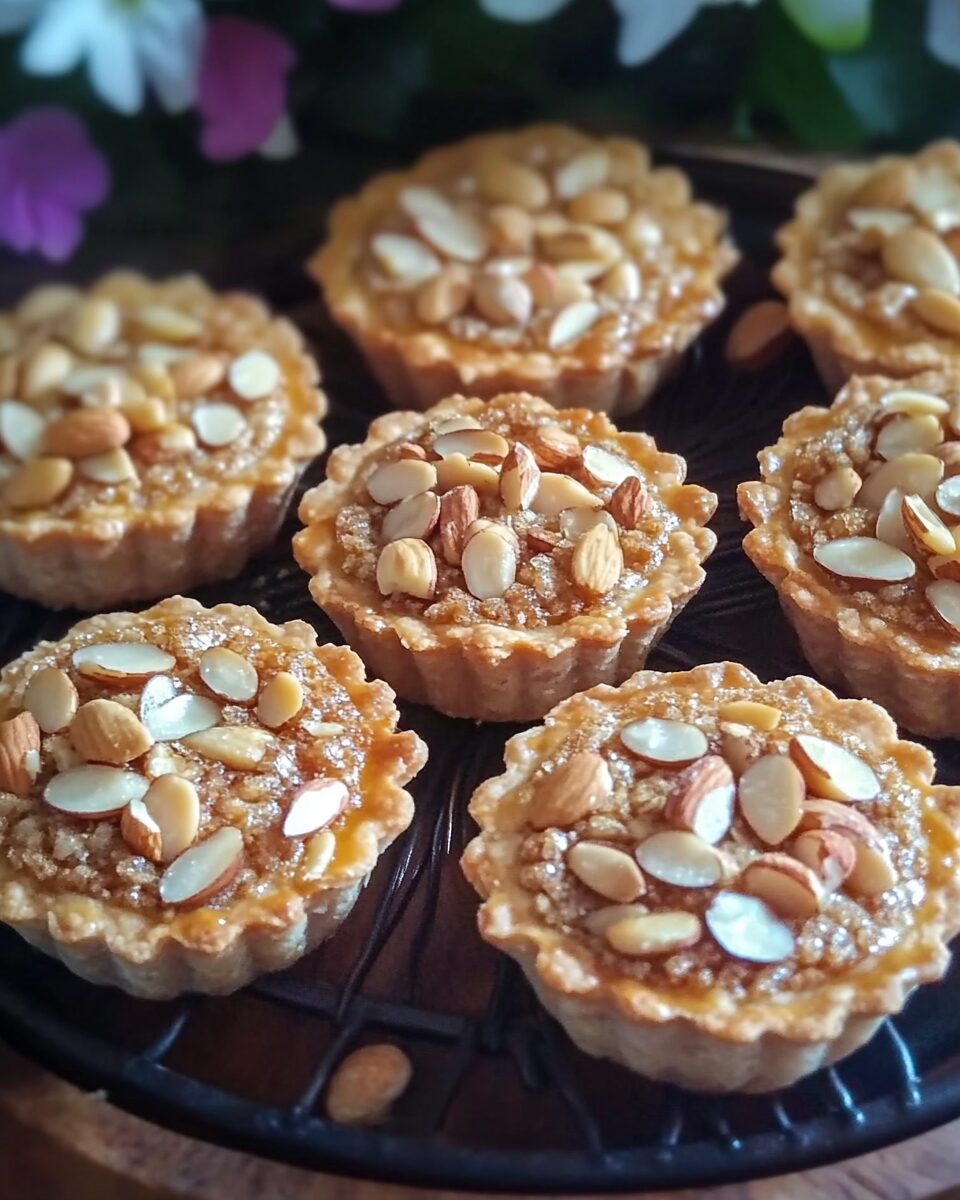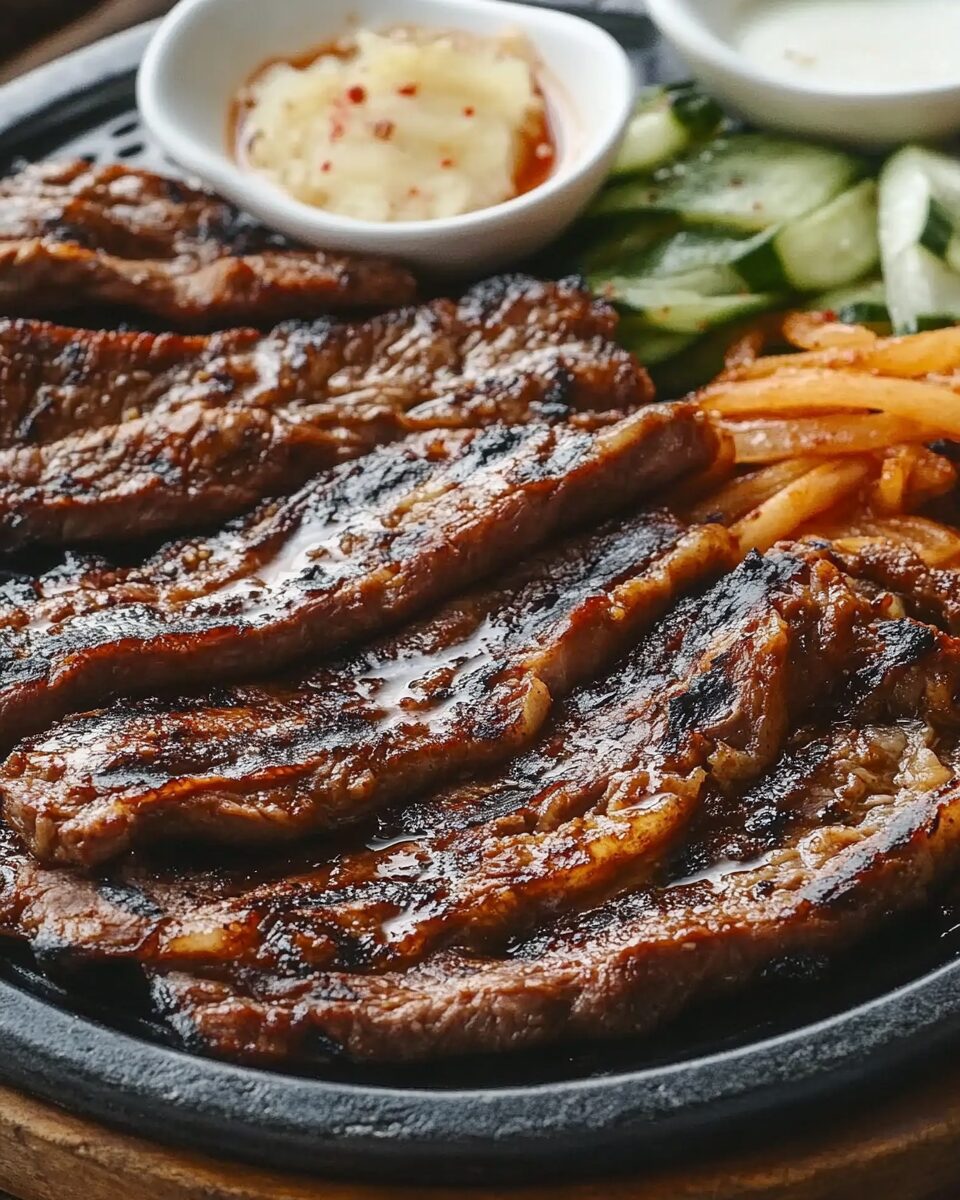Dziriat, or Algerian almond tarts, are a delectable and traditional North African pastry. These small, elegant treats are filled with a sweet almond paste, giving them a rich flavor and a tender texture. The dough is delicate and buttery, perfectly complementing the nutty filling. Popular during special occasions, especially during Ramadan or festive celebrations, Dziriat is enjoyed by many for its simplicity and delightful taste. Whether you’re serving them at a gathering or indulging in a treat with tea, these almond tarts are sure to impress anyone with a sweet tooth.
Full Recipe:
Ingredients
- 1 cup all-purpose flour
- ½ cup powdered sugar
- 1 teaspoon baking powder
- 1 teaspoon vanilla extract
- ½ cup unsalted butter, softened
- 1 large egg
- 1 egg yolk
- 1 tablespoon warm water
- 1 ½ cups ground almonds
- ½ cup powdered sugar (for filling)
- 1 teaspoon rose water (optional)
- 1 tablespoon orange blossom water (optional)
- 1 egg white (for brushing)
- A pinch of ground cinnamon (optional)
Directions
- Preheat the oven to 350°F (175°C). Lightly grease or line a baking sheet with parchment paper.
- In a bowl, combine the flour, powdered sugar, and baking powder. Add the softened butter and mix until the mixture resembles coarse crumbs.
- Add the egg, egg yolk, and vanilla extract to the flour mixture. Gradually mix in warm water until a dough forms. Knead gently until the dough is smooth.
- For the filling, combine ground almonds, powdered sugar, and rose water and orange blossom water (if using) in a bowl. Mix until a thick paste forms.
- Roll out the dough on a floured surface to about ¼-inch thickness. Cut the dough into small rounds using a cookie cutter or a glass.
- Place a spoonful of almond filling in the center of each round, folding the edges over to form a small tart.
- Brush the tops of each tart with egg white and sprinkle with a pinch of cinnamon (if desired).
- Place the tarts on the prepared baking sheet and bake for 15-20 minutes, or until golden brown.
- Allow the tarts to cool on a wire rack before serving.
Nutrients
- Calories: 180 kcal per tart
- Fat: 12g
- Saturated Fat: 7g
- Cholesterol: 40mg
- Sodium: 40mg
- Carbohydrates: 18g
- Fiber: 2g
- Sugar: 8g
- Protein: 3g
The Rich History and Cultural Significance of Dziriat
Dziriat are deeply rooted in the traditions of Algeria and the wider Maghreb region, where sweets and pastries have long been an integral part of culinary culture. The use of almonds in desserts has been a common feature of Middle Eastern and North African cuisines for centuries. Almonds were prized for their versatility in both savory and sweet dishes, offering richness and a satisfying texture to many traditional recipes.
Algerian desserts often reflect the influence of different cultures that have historically shaped the region. The Berber people, Arab conquerors, and the French colonial era all left their mark on the food traditions of Algeria, and Dziriat is no exception. These almond tarts, though simple in their composition, have a sophisticated flavor profile that represents the convergence of diverse culinary influences. The use of almond paste, along with rose and orange blossom waters, speaks to the Arab tradition of infusing desserts with delicate floral aromas that elevate the sweetness of the dish.
In Algerian households, Dziriat is often served during major holidays such as Eid al-Fitr, weddings, and during Ramadan, where sweets play an important role in celebratory meals. The act of making these tarts is often a family affair, passed down through generations. The preparation and sharing of Dziriat is a time to connect with loved ones and celebrate both heritage and togetherness.
The Importance of Almonds in Algerian Cuisine
Almonds have a prominent place in Algerian and Maghreb cuisine, especially in sweets and pastries. The use of almonds in Dziriat not only provides a rich and nutty flavor but also a satisfying texture that contrasts with the soft, delicate pastry shell. Almonds have been cultivated in the Mediterranean region for thousands of years, and their incorporation into desserts like Dziriat is a testament to their importance in North African culinary traditions.
Beyond their flavor and texture, almonds also have symbolic significance. In many cultures, almonds are seen as a symbol of fertility, prosperity, and good fortune, making them a popular ingredient in celebratory foods. Whether they are ground into a paste or used whole, almonds bring an element of richness and depth to the flavors of traditional Algerian sweets.
The versatility of almonds in Algerian cuisine extends beyond desserts. They are also used in savory dishes, like lamb or chicken stews, where they provide both texture and a subtle sweetness that balances the savory elements of the dish. However, it is in pastries like Dziriat where almonds truly shine, providing a luxurious, nutty backdrop for the other flavors in the tart.
The Role of Floral Waters: Rose and Orange Blossom
One of the distinctive characteristics of Dziriat is the use of floral waters such as rose water and orange blossom water, which are common ingredients in North African desserts. These aromatic waters add an enchanting fragrance and a touch of elegance to the almond filling, setting Dziriat apart from more straightforward nut-based pastries.
Rose water has a delicate floral aroma and is often used in Middle Eastern and North African desserts, from cakes to syrups. It adds a gentle, slightly sweet fragrance that enhances the overall sensory experience of eating the tart. Similarly, orange blossom water brings a citrusy, fragrant note that complements the almonds and adds depth to the filling. These two floral waters together create a balanced, aromatic flavor profile that is a hallmark of traditional Algerian sweets.
While floral waters are sometimes an acquired taste for those unfamiliar with their subtle flavors, they are an essential part of the cultural and culinary identity of the Maghreb region. Their use in Dziriat exemplifies the region’s love for perfumes and scents, which permeate not only the air but also the food, making each bite a sensory experience.
The Art of Making Dziriat: A Perfect Balance of Dough and Filling
Making Dziriat requires a careful balance between the delicate dough and the rich almond filling. The dough should be tender, buttery, and light, allowing the almond filling to take center stage. Achieving the perfect texture for the dough is key, as it should be easy to work with yet hold its shape when baked. The use of butter and powdered sugar in the dough ensures a melt-in-your-mouth experience, while the addition of egg yolks helps bind the dough together without making it too tough.
The filling itself is made from finely ground almonds, sugar, and floral waters, creating a paste-like consistency that is both smooth and aromatic. The filling should be sweet but not overpowering, allowing the flavor of the almonds to shine through. The mixture is spooned into small rounds of dough, which are then folded or shaped into tarts. This process, while simple, requires precision to ensure that the tarts hold their shape and bake evenly.
Baking the tarts requires patience, as the goal is to achieve a golden, slightly crisp outer shell while maintaining a soft and moist almond filling. Overbaking can lead to a dry texture, so it is important to keep an eye on the tarts as they bake to achieve the perfect balance of tenderness and crunch.
Modern Twists on a Traditional Recipe
While Dziriat is traditionally made using ground almonds, there are modern variations of the recipe that incorporate different ingredients to give the tarts a unique twist. Some variations may include adding a hint of cinnamon or nutmeg to the almond paste, providing a warm, aromatic flavor that complements the sweetness of the almonds. Others may use a combination of almond and hazelnut paste for a richer, more complex filling.
For those with dietary restrictions, Dziriat can be adapted to be gluten-free by using almond flour instead of all-purpose flour for the dough. Additionally, plant-based alternatives can be used for butter and eggs, making this pastry suitable for vegans. While these variations may alter the traditional recipe, they still maintain the spirit of Dziriat and showcase the versatility of this Algerian pastry.
Serving and Enjoying Dziriat
Dziriat is best enjoyed fresh from the oven or after it has had time to cool down to room temperature. The tarts can be served as part of a larger spread of desserts during festive occasions, or as a special treat to accompany a cup of mint tea. In Algeria, it is common to serve Dziriat alongside other pastries, like makroud or baklava, for a sweet ending to a meal.
The tarts are often dusted with powdered sugar or garnished with slivers of almonds for added elegance. The rich, nutty flavor of the almond paste pairs perfectly with the floral aroma of the dough, creating a treat that is both visually appealing and delicious.
For a truly authentic experience, serve Dziriat with a glass of mint tea, a drink that is just as integral to Algerian culture as the tarts themselves. The combination of the sweet tarts and the refreshing tea creates a balanced and satisfying culinary moment that highlights the beauty of Algerian cuisine.
Conclusion
Dziriat, the Algerian almond tarts, are a perfect example of how simple ingredients can come together to create a rich, flavorful dessert that has stood the test of time. These tarts are more than just a sweet treat; they are a symbol of Algerian hospitality, culture, and tradition. With their delicate dough, aromatic almond filling, and floral notes, Dziriat capture the essence of North African sweets and are a perfect way to celebrate both family and festivity.








